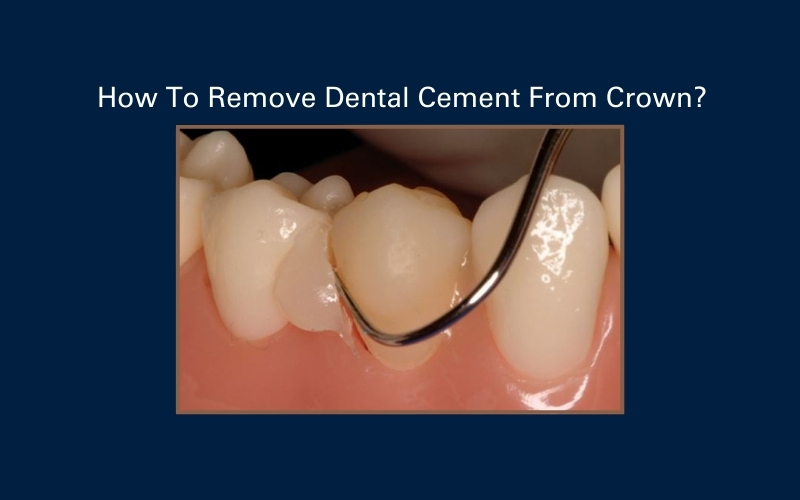How To Remove Dental Cement From Crown?

Dental crowns play a crucial role in restoring damaged teeth. They provide strength and protection, ensuring your smile remains intact. Dental cement bonds these crowns securely to your teeth.
However, you might need to remove this cement for various reasons, such as replacing or adjusting the crown. Proper removal techniques are essential to avoid damaging both the crown and the underlying tooth structure.
This blog will explore how to safely and effectively remove dental cement from a crown.
Understanding Dental Cement
Dental cement comes in various types, each serving a specific purpose. Common types include resin cement, glass ionomer, and zinc phosphate. Each type has different properties, affecting how it adheres to crowns and teeth.
You may need to remove dental cement for several reasons. The most common is crown replacement. Over time, a crown may wear down or become damaged. Another reason is adjustment. Sometimes, the fit may not be perfect, leading to discomfort.
In both cases, removing the cement is crucial for a successful outcome. Understanding the type of cement used and the reason for removal helps guide your approach.
Step-by-Step Removal Process
Removing dental cement from a crown requires careful attention to detail and a steady hand. Follow these steps to ensure a successful removal.
Preparation
Before you begin, gathering all necessary tools and ensuring your workspace is clean is essential. You will need a dental explorer, scaler, and warm water. You may also want dental solvents, which can help soften the cement.
Choose a well-lit area free from distractions. This will help you focus on the task at hand. Wash your hands and wear gloves to maintain hygiene throughout the process. A clean workspace reduces the risk of introducing bacteria or debris, which can lead to complications later.
Assess the Crown
Once you are prepared, examine the crown and the surrounding area closely. Look for any visible signs of damage, such as cracks or chips. Understanding the condition of the crown helps determine the best approach for removal. If you notice significant damage, it may be wise to consult a dentist instead of attempting the removal yourself.
Take note of how the crown fits and whether it feels loose or secure. If the crown seems stable, you can proceed with the removal. However, if it is excessively loose, further caution is required to avoid harming the underlying tooth structure.
Softening the Cement
Next, it is time to soften the cement. This step is crucial, as hardened dental cement can be challenging to remove. Warm water can help soften the bond. Soak a cotton ball in warm water and apply it to the cemented area for a few minutes.
Alternatively, you can use dental solvents specifically designed for this purpose. These products are available at dental supply stores and can effectively break down the cement. Apply the solvent according to the manufacturer’s instructions, allowing it to sit long enough to soften the cement.
Removing the Cement
After softening the cement, it is time to start removing it. Use your dental explorer or scaler to scrape away the softened cement gently. Start at the edges of the crown where the cement is most accessible. Apply light pressure to avoid damaging the crown or tooth.
Work slowly and methodically, ensuring you’re not rushing the process. If you encounter resistance, stop and apply more warm water or solvent. Continue scraping until you have removed all visible traces of the cement. Be patient. This process can take time, but rushing can lead to mistakes.
If the crown feels stuck, you may need to gently pry it off. Use your tools carefully to avoid applying too much force. If you are unsure or feel resistance, it is best to stop and seek professional help to avoid damaging your tooth or the crown.
Cleaning the Area
Once you have successfully removed the cement, it is essential to clean the area thoroughly. Residual cement can lead to irritation, infection, or complications during future dental work. Rinse the crown and the area with warm water to remove any leftover cement particles.
After rinsing, inspect the crown and the underlying tooth for any remaining debris. Use a soft toothbrush to scrub the crown, ensuring it is completely clean gently. Pay special attention to the edges where cement may have clung stubbornly.
Finally, dry the area with a clean, soft cloth. Ensuring that everything is clean and dry is critical for the next steps in your dental care, whether it’s re-cementing the crown or planning for a replacement.
Tools and Materials Needed
To effectively remove dental cement, you will need specific tools. Here is a list of essential items:
- Dental Explorer: Ideal for examining and scraping.
- Scaler: Useful for gently removing cement.
- Warm Water: Helps soften the cement.
- Dental Solvents: Specialized products for effective removal.
Safety equipment is equally important. Always wear gloves to maintain hygiene. A mask can protect against any dust or particles released during the process. Proper tools and safety measures ensure a successful removal.
Aftercare
After removing dental cement, maintaining good oral hygiene is crucial. Brush and floss gently around the area to keep it clean. Rinse with an antibacterial mouthwash to reduce the risk of infection.
Watch for any signs of complications. These include swelling, persistent pain, or bleeding. If you notice any of these issues, seek professional help. Staying vigilant after the procedure helps ensure your dental health remains intact.
When to Seek Professional Help?
While some may attempt to remove dental cement themselves, there are situations where DIY is not recommended. If the cement is stubborn or if you feel unsure about the process, it’s best to consult a dentist. They have the tools and expertise to handle complex cases safely.
Additionally, do not hesitate to seek professional assistance if you suspect damage to the crown or underlying tooth. A dentist can assess the situation and provide the appropriate treatment, preventing further complications.
Removing dental cement from a crown requires careful preparation and technique. Assess the crown, soften the cement, and remove it gently. Clean the area thoroughly afterward. Consulting a dental professional is always the safest option if you have any doubts. Taking these steps will help ensure your dental health and comfort are maintained.

